Are you a fish enthusiast who is considering adding platies to your 55-gallon tank? If so, you may be wondering how many of these colorful and lively fish would be the perfect fit for your aquarium. In this article, we will explore a simple and effective method to calculate the ideal number of platies for a 55-gallon tank. By considering factors such as the fish’s size, behavior, and care requirements, you’ll be able to create a harmonious and thriving environment for your platies. So let’s dive in and discover the ideal number of platies for your tank!
Calculate the Ideal Number of Platies
If you’re wondering how many platies you can keep in a 55 gallon tank, there are several factors to consider in order to ensure the well-being and comfort of your fish. In this article, we will guide you through the process of calculating the ideal number of platies for your tank. By considering the tank size, the 1 inch of fish per gallon rule, the activity level of platies, their maturity, and their compatibility, you can create a harmonious and thriving environment for your aquatic companions.
Consider the Tank Size
The first step in determining the ideal number of platies for your tank is to consider the size of the tank itself. A 55 gallon tank provides a good amount of space for your fish to thrive. However, it’s important to understand the capacity of this tank and ensure that there is sufficient space for your platies to swim freely.
Apply the 1 Inch of Fish per Gallon Rule
To estimate the number of platies you can keep in your 55 gallon tank, you can apply the commonly used 1 inch of fish per gallon rule. This rule suggests that you can have one inch of fish per gallon of water in your tank. However, it’s vital to take into account the adult size of platies rather than their current size when applying this rule.
Factor in the Activity Level of Platies
Platies are known for their active nature and love for swimming. When determining the ideal number of platies for your tank, it’s crucial to consider their activity level. Take into account the swimming and breathing habits of platies to ensure that they have sufficient room to move around comfortably within the tank.
Account for the Maturity of the Fish
Considering the maturity of the fish is an essential aspect of calculating the ideal number of platies. You need to consider their age and size, as well as their growth potential. Juvenile platies may initially seem small and accommodate more individuals in the tank. However, it’s important to avoid overstocking juvenile platies, as they will grow in size and require more space as they mature.
Consider the Compatibility of Platies
Platies are generally known to be peaceful and sociable fish. However, compatibility should be taken into account when determining the ideal number of platies for your tank. Assess the aggression levels of platies and evaluate potential tank mates. It’s essential to avoid overcrowding and aggression issues that may arise from incompatible tank mates.
Monitor Water Parameters
To ensure the well-being of your platies, it’s crucial to monitor and maintain optimal water parameters in your tank. Understand the importance of maintaining suitable temperature, pH, and ammonia levels. Regularly check and adjust these parameters to create a healthy and stable environment for your fish.
Provide Sufficient Hiding Spots
Creating a natural environment in your tank is important for the well-being of your platies. Use decorations or live plants to offer hiding spots and retreat options for your fish. This will allow them to feel secure and reduce stress levels, leading to a more harmonious tank environment.
Consider the Biological Load
The biological load in your tank refers to the amount of waste produced by your platies. When calculating the ideal number of platies, it’s important to account for the waste production and factor in fish feeding and waste management. Overstocking your tank can lead to an excessive biological load, which can negatively impact water quality and the health of your fish.
Observe and Adjust
Even after calculating the ideal number of platies based on all the aforementioned factors, it’s important to continuously monitor your fish behavior and health. Observe how your platies are interacting with each other and their environment. If necessary, make adjustments by either adding or removing fish to maintain a balanced and thriving aquarium.
In conclusion, calculating the ideal number of platies for a 55 gallon tank involves considering the tank size, applying the 1 inch of fish per gallon rule, factoring in the activity level and maturity of platies, considering their compatibility with other tank mates, and monitoring water parameters and waste production. By taking all these factors into account and continually observing and adjusting, you can create a beautiful and harmonious underwater world for your platies to thrive in.
